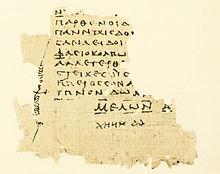Our website is made possible by displaying online advertisements to our visitors.
Please consider supporting us by disabling your ad blocker.
Papyrus Oxyrhynchus 1231

Papyrus Oxyrhynchus 1231 (P. Oxy. 1231 or P. Oxy. X 1231) is a papyrus discovered at Oxyrhynchus in Egypt, first published in 1914 by Bernard Pyne Grenfell and Arthur Surridge Hunt.[1] The papyrus preserves fragments of the second half of Book I of a Hellenistic edition of the poetry of the archaic poet Sappho.[a][1]
The papyrus comes from a second century AD roll,[3] and is made up of 56 smaller fragments.[4] The largest piece, fragment one, measures 17.7 cm × 13.2 cm; it covers two columns and includes fragments of four poems.[4] It is written in a small informal upright hand, and corrections and marginalia have been added in a second hand, using a different ink.[5]
The papyrus preserves a number of fragments by Sappho. Fragment one of the papyrus preserves four consecutive fragments; frr. 15, 16, 17, and 18 in Voigt's edition.[6] Also preserved, on fragment 56 of the papyrus, is the final poem of Book I of Sappho, fragment 30.[7] A colophon at the end of fragment 56 of the papyrus shows that Sappho's Book I contained 1320 lines, or 330 stanzas.[7] Sappho's name is not preserved here; instead, the authorship of the fragments is established by the metre (Sapphic stanzas), dialect (Aeolic), and three overlaps with previously-known fragments attributed to Sappho.[4]
The papyrus is now in the collection of the Bodleian Library.[3]
- ^ a b Bierl & Lardinois 2016, p. 1.
- ^ Rayor & Lardinois 2014, p. 102.
- ^ a b Obbink 2016a, p. 15.
- ^ a b c Grenfell & Hunt 1914, p. 20.
- ^ Grenfell & Hunt 1914, p. 21.
- ^ Obbink 2016b, p. 46, n. 42.
- ^ a b Obbink 2016b, p. 43.
Cite error: There are <ref group=lower-alpha> tags or {{efn}} templates on this page, but the references will not show without a {{reflist|group=lower-alpha}} template or {{notelist}} template (see the help page).
Previous Page Next Page


